Canadian Energy Centre
Completing Trans Mountain, Indigenous LNG: What to watch in Canadian energy in 2024
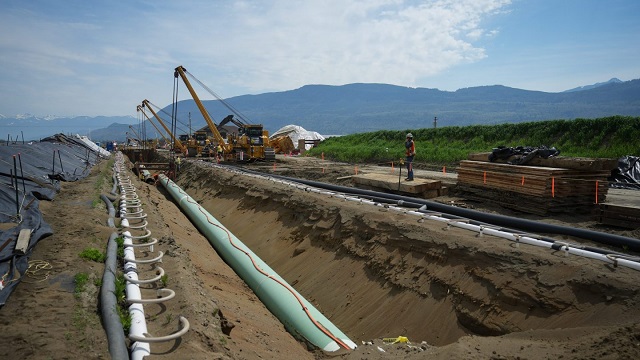
Workers lay pipe during construction of the Trans Mountain pipeline expansion on farmland in Abbotsford, B.C., on May 3, 2023. CP Images photo
From the Canadian Energy Centre
By Deborah JaremkoActivity promises to highlight Canada’s position as a world supplier of choice
It’s going to be a big year for Canadian energy, with major milestones anticipated that will transform Canada from a supplier with a single customer (the United States) to a global player.
Global demand for oil and gas is expected to stay strong in the decades ahead as the world works to reduce emissions, still supplying nearly half of energy needs in 2050, according to the International Energy Agency.
Activity in 2024 promises to highlight Canada’s position as a supplier of choice with a leading approach to reducing emissions and engaging Indigenous communities.
Here are five things to watch.
5. Start-Up Activities for LNG Canada

Construction of the LNG Canada export terminal is now more than 90 per cent complete. Photo courtesy LNG Canada
Against the backdrop of surging liquefied natural gas (LNG) demand – Asia’s consumption hit a record 26.6 million tonnes in December – Canada’s first LNG export terminal is preparing for start-up.
LNG Canada will have among the world’s lowest emissions for LNG supply, at 0.15 tonnes of CO2 equivalent per tonne of LNG, less than half the global average.
This year, the terminal at Kitimat, B.C. will test and fine-tune equipment and the process of producing LNG will begin, the company says.
The start-up program will take more than one year to complete.
Moving into the final stages at LNG Canada follows the recent completion of the Coastal GasLink Pipeline, connecting natural gas supply from northeast B.C.
4. Progress Toward Oil Sands Net Zero

The Pathways Alliance has extensive work underway on the environmental program for its proposed CCS project, involving 135 experts ranging from aquatic and wildlife biologists to archeologists and paleontologists who have spent more than 1,600 hours in the field working to minimize environmental disturbance. Photo courtesy Pathways Alliance
Major regulatory applications are expected in 2024 for one of the world’s largest proposed carbon capture and storage (CCS) networks, located in Canada’s oil sands.
The project would connect CO2 captured at an initial 14 oil sands facilities by pipeline to a shared hub for storage deep underground.
It is the foundation of the plan by the Pathways Alliance – companies representing 95 per cent of oil sands production – to reduce emissions from operations by nearly one third by 2030 on the way to net zero by 2050.
Pathways has said that after regulatory approvals are complete, CO2 injection and storage could begin by late 2026.
3. Growth in Indigenous Ownership

Eva Clayton, back left, President of the Nisga’a Lisims Government (joint venture owner of the proposed Ksi Lisims LNG project), Crystal Smith, back right, Haisla Nation Chief Councillor (joint venture owner of proposed Cedar LNG project), and Karen Ogen, front right, CEO of the First Nations LNG Alliance pose for a photograph on the HaiSea Wamis zero-emission tugboat outside the LNG2023 conference, in Vancouver, B.C., Monday, July 10, 2023. CP Images photo
The rising tide of Indigenous ownership in Canadian energy is likely to continue growing in 2024.
From LNG terminals to oil and gas pipelines, natural gas-fired power plants and CCS projects to reduce emissions, more Indigenous communities are taking on a leadership role.
Since 2022, more than 75 First Nations and Métis communities in Alberta and British Columbia have agreed to ownership stakes in energy projects including the Coastal GasLink pipeline and major oil sands transportation networks.
Indigenous loan guarantee programs like those offered by the Alberta Indigenous Opportunities Corporation (AIOC) are helping communities invest.
So far, the AIOC has underwritten more than $500 million in loan guarantees. This year it has $3 billion of support available, up from $2 billion in 2023.
Details of a proposed national loan guarantee program to help facilitate Indigenous equity ownership in major resource projects are also expected in the federal budget this spring.
2. Green Light for Cedar LNG
Owners of the world’s first Indigenous-led LNG project – a floating terminal at Kitimat, B.C. –plan to make the final decision to proceed within the next three months.
Cedar LNG, owned jointly by the Haisla Nation and Pembina Pipeline Corporation, would have capacity to export three million tonnes of LNG per year, primarily to Asian markets.
With emissions intensity of 0.08 tonnes of CO2 equivalent per tonne of LNG, it would be one of the lowest carbon footprint LNG projects in the world.
In early January, the partners reached the critical milestone of selecting the primary contractors to engineer, build and deliver the floating LNG unit.
A final investment decision is now expected in the first quarter of 2024.
1. Completion of the Trans Mountain Pipeline Expansion
After more than 12 years in the making, Canada’s first large-scale access to growing global oil markets is now weeks away from completion.
The existing Trans Mountain pipeline system from Edmonton, Alberta to Burnaby, B.C. runs consistently at maximum capacity with producers seeking more export space than is available.
The expansion will increase service by about 600,000 barrels per day, bringing more Canadian oil to customers around the world, primarily on the U.S. west coast and Asia.
After the recent resolution of a regulatory delay, Trans Mountain can now proceed with the last two per cent of construction.
The company anticipates oil will flow on the expanded line before the end of March.
Alberta
Canada’s advantage as the world’s demand for plastic continues to grow

From the Canadian Energy Centre
By Will Gibson
‘The demand for plastics reflects how essential they are in our lives’
From the clothes on your back to the containers for household products to the pipes and insulation in your home, plastics are interwoven into the fabric of day-to-day life for most Canadians.
And that reliance is projected to grow both in Canada and around the world in the next three decades
The Global Plastics Outlook, published by the Paris-based Organization for Economic Co-operation and Development (OECD), forecasts the use of plastics globally will nearly triple by 2060, driven by economic and population growth.
The use of plastics is projected to double in OECD countries like Canada, the United States and European nations, but the largest increases will take place in Asia and Africa.
“The demand for plastics reflects how essential they are in our lives, whether it is packaging, textiles, building materials or medical equipment,” says Christa Seaman, vice-president, plastics with the Chemical Industry Association of Canada (CIAC), which represents Canada’s plastics producers.
She says as countries look to meet climate and sustainability goals, demand for plastic will grow.
“Plastics in the market today demonstrate their value to our society. Plastics are used to make critical components for solar panels and wind turbines. But they also can play a role in reducing weight in transportation or in ensuring goods that are transported have less weight in their packaging or in their products.”
Canada produces about $35 billion worth of plastic resin and plastic products per year, or over five per cent of Canadian manufacturing sales, according to a 2019 report published by the federal government.
Seaman says Canadian plastic producers have competitive advantages that position them to grow as demand rises at home and abroad. In Alberta, a key opportunity is the abundant supply of natural gas used to make plastic resin.
“As industry and consumer expectations shift for production to reduce emissions, Canada, and particularly Alberta, are extremely well placed to meet increased demand thanks to its supply of low-carbon feedstock. Going forward, production with less emissions is going to be important for companies,” Seaman says.
“You can see that with Dow Chemical’s decision to spend $8.8 billion on a net zero facility in Alberta.”
While modern life would not be possible without plastics, the CIAC says there needs to be better post-use management of plastic products including advanced recycling, or a so-called “circular economy” where plastics are seen as a resource or feedstock for new products, not a waste.
Some companies have already started making significant investments to generate recyclable plastics.
For example, Inter Pipeline Ltd.’s $4.3 billion Heartland Petrochemical Complex near Edmonton started operating in 2023. It produces a recyclable plastic called polypropylene from propane, with 65 per cent lower emissions than the global average thanks to the facility’s integrated design.
Achieving a circular economy – where 90 per cent of post-consumer plastic waste is diverted or recycled – would benefit Canada’s economy, according to the CIAC.
A Deloitte study, commissioned by Environment & Climate Change Canada, estimated diverting or reusing 90 per cent of post-consumer plastic waste by 2030 will save $500 million annually while creating 42,000 direct and indirect jobs. It would also cut Canada’s annual CO2 emissions by 1.8 megatonnes.
Right now, about 85 per cent of plastics end up in Canada’s landfills. To reach the 90 per cent diversion rate, Seaman says Canada must improve its infrastructure to collect and process the plastic waste currently being landfilled.
But she also says the industry rather than municipalities need to take responsibility for recycling plastic waste.
“This concept is referred to as extended producer responsibility. Municipalities have the responsibility for managing recycling within a waste management system. Given the competing costs and priorities, they don’t have the incentive to invest into recycling infrastructure when landfill space was the most cost-effective solution for them,” she says.
“Putting that responsibility on the producers who put the products on the market makes the most sense…The industry is adapting, and we hope government policy will recognize this opportunity for Canada to meet our climate goals while growing our economy.”
Business
Decarbonization deal opens new chapter in Alberta-Japan relationship

From the Canadian Energy Centre
By Will Gibson
Agreement represents a homecoming for JAPEX, which first started work in the Alberta oil sands in 1978
A new agreement that will see Japan Petroleum Exploration Company (JAPEX) invest in decarbonization opportunities in Alberta made history while also being rooted in the past, in the eyes of Gary Mar.
JAPEX is seeking to develop projects in carbon capture and storage (CCS), hydrogen and bioenergy. It’s part of the company’s JAPEX2050 strategy toward carbon neutrality.
“This new endeavour is a great opportunity that demonstrates the world is changing but the relationships endure,” says Mar, the province’s former trade envoy to Asia and the current CEO of the Canada West Foundation.
“Alberta’s very first international office was opened in Tokyo in 1981. And we have built a tremendous soft infrastructure that includes partnerships between a dozen Alberta and Japanese universities.”
For JAPEX, the agreement represents something of a homecoming for the company that first started work in the Alberta oil sands in 1978 and operated one of the first in situ (or drilled) oil projects for nearly two decades before selling its stake in 2018.
“We are now aiming to come back to Alberta and contribute to its decarbonization,” JAPEX president of overseas business Tomomi Yamada said in a statement.
Mar says the memorandum of understanding signed this March between JAPEX and the crown corporation Invest Alberta stems from a strong relationship built over decades.
“You can’t be considered a reliable partner for a new venture if you haven’t been a reliable partner for decades in the past,” says Mar.
“Economies change and world’s needs change but strong relationships are important factor in whom you do business with.”
Alberta’s established CCS infrastructure has already attracted new investment, including Air Products’ $1.6-billion net zero hydrogen complex and Dow Chemicals’ $8.8-billion net zero petrochemical complex.
Mar sees JAPEX’s deal with Invest Alberta opening a whole new market of potential carbon neutral investors in the Pacific Rim.
“When other countries who are partners in the Trans-Pacific Partnership (TPP) see JAPEX invest in this decarbonization opportunities and net zero projects in Alberta, it will send a very clear signal to others in the TPP about the potential,” Mar says.
“This deal may come from the decades-long relationship between Alberta and Japan but can also serve as a signpost for decades to come.”
-

 COVID-191 day ago
COVID-191 day agoPfizer reportedly withheld presence of cancer-linked DNA in COVID jabs from FDA, Health Canada
-
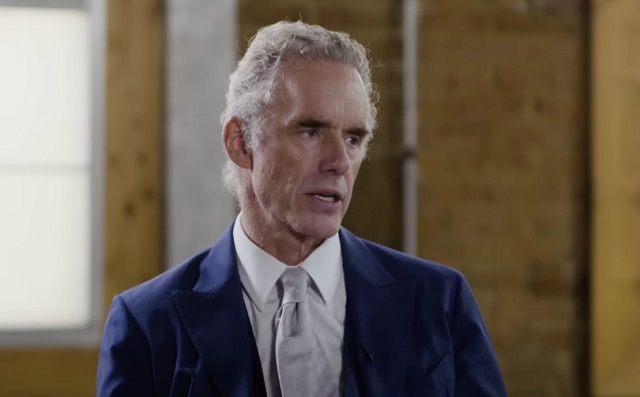
 Censorship Industrial Complex2 days ago
Censorship Industrial Complex2 days agoJordan Peterson, Canadian lawyer warn of ‘totalitarian’ impact of Trudeau’s ‘Online Harms’ bill
-

 COVID-1919 hours ago
COVID-1919 hours agoTrudeau gov’t has paid out over $500k to employees denied COVID vaccine mandate exemptions
-

 Alberta2 days ago
Alberta2 days agoAlberta official reveals ‘almost all’ wildfires in province this year have been started by humans
-
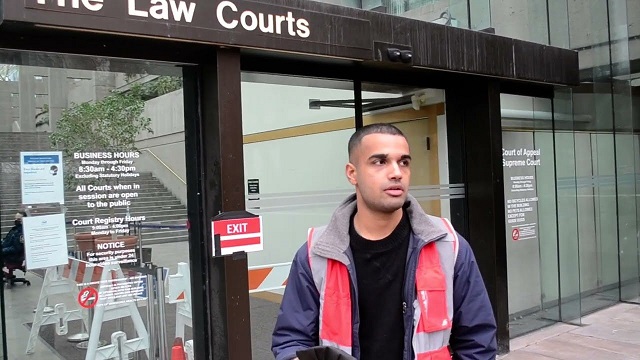
 Bruce Dowbiggin2 days ago
Bruce Dowbiggin2 days agoCome For The Graduate Studies, Stay For The Revolution
-
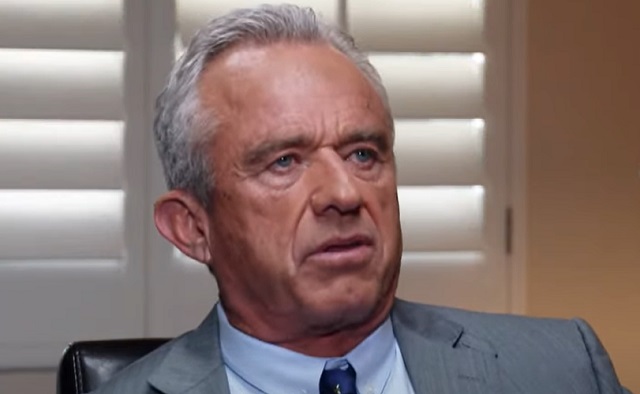
 International18 hours ago
International18 hours agoRFK Jr tells EWTN: Politicization of the CIA, FBI, Secret Service under Biden is ‘very troubling’
-
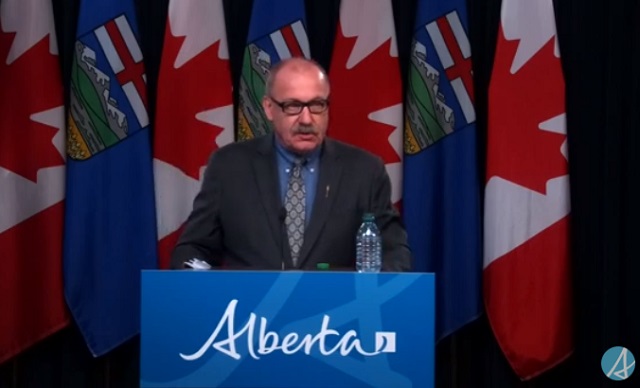
 Alberta2 days ago
Alberta2 days agoPolitical parties will be part of municipal elections in Edmonton and Calgary pilot projects
-

 National24 hours ago
National24 hours agoAnger towards Trudeau government reaches new high among Canadians: poll









